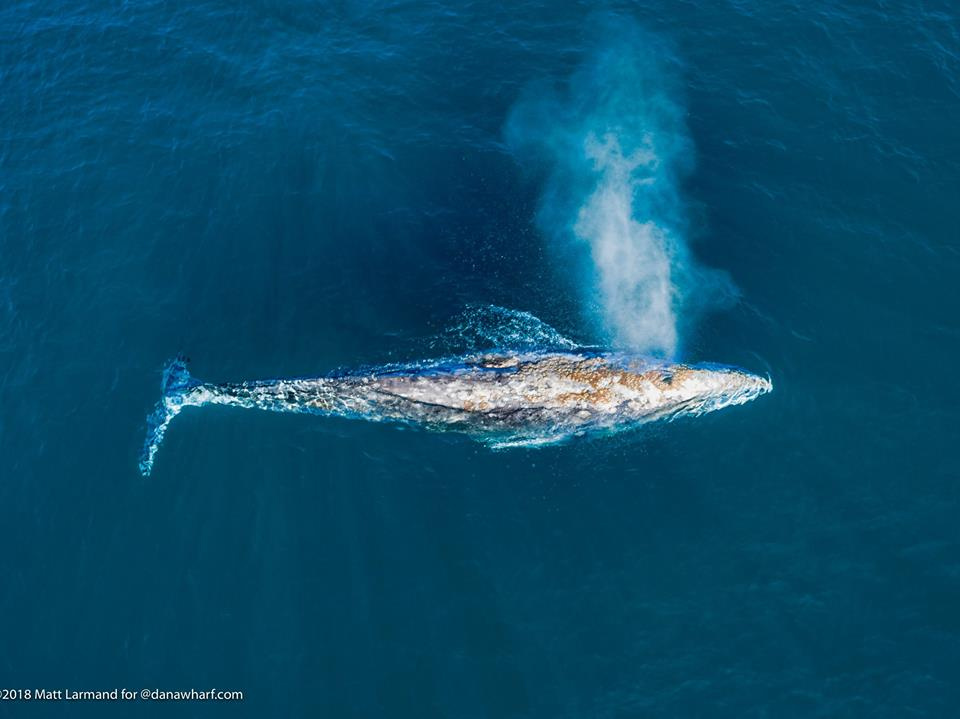
The first southbound gray whales of the season were spotted Thursday, Dec. 8 — one cruising close to shore along the Palos Verdes cliffs in the early morning and another spotted off Dana Point — on their way to the warm water lagoons in Mexico.
The annual migration from their feeding ground in Alaska is the longest of any mammal, estimated at 12,000 miles, a journey that spurs excitement among whale enthusiasts who like to get up close to see the traveling whales.
Alisa Schulman-Janiger, who heads the American Cetacean Society Gray Whale Census and Behavior Project off Point Vicente, spotted the southbound whale at about 6:30 a.m. close to shore just outside the kelp beds. It was the second sighting of a gray whale for Schulman-Janiger, who saw a northbound gray on Dec. 1, a rare sight for this time of year as most gray whales are heading south.
The big gray whale spotted on Thursday was so close that the volunteers doing the census could hear its blow from on the cliff.
“I was scanning with my binoculars. I saw its back and blow in my binoculars,” she said. “We couldn’t believe it, then we all heard it.”
The day was exceptional for whale enthusiasts, with several fin whales, the world’s second-largest mammal, and a blue whale, the world’s largest, still sticking around feeding. There was also a big pod of offshore bottlenose dolphins mixing with common dolphins, she said.
While the fin and blue whales are exciting because of their massive size, the gray whales are the more predictable creatures that always show up this time of year.
Dana Wharf Whale Watching captain Steve Burkhalter spotted a gray whale just as a charter group left the Dana Point Harbor.
“They are kind of on their road trip,” he said.
The whale showed up near the Dana Point Headlands as the group was heading out to see a humpback and common dolphins.
“It literally came up right next to us, it kind of found us,” he said. “I stopped the boat, we got some good looks at it.”
The gray whale season typically spans from December through March and April when they head north back to Alaska.
“I think when people think of whale watching of California, they think of gray whales,” he said. “It’s always cool to ring in the season seeing the first one.”
The gray whale he spotted Thursday looked like a healthy juvenile whale.
That’s a good sign for the species that has been under the watchful eye of marine scientists since the National Oceanic Atmospheric Administration in 2019 declared an Unusual Mortality Event after an alarming number of dead gray whales — many starved and emaciated — started washing up along the West Coast.
Related Articles
OC Habitat looking for support to grown programs
OP Pro exhibit remembers history-making surf contest — and its famed 1986 riot
Lightweight Navy torpedo found floating in ocean off Dana Point
South swell combining this week with higher tides
Effort to save shorelines at Capistrano and Doheny beaches approved, but $8 million+ still needed
That year, there were 214 gray whale strandings in Canada, the U.S. and Mexico. In the U.S., there were 122: 48 in Alaska, 34 in California, 34 in Washington and six in Oregon.
The following year, 2020, 172 washed up dead from Canada to Mexico. In 2021, the number was 115, and last year it was 104.
“We don’t know if it’s going to continue into this season; that’s what we’ll keep an eye on,” said Schulman-Janiger.
Researchers will be looking for four factors: the body condition of the whale and whether they look emaciated, the timing of the migration and if they are later than usual due to foraging for food longer, the number of calves and the number of strandings or deaths, she said.
In a typical year, based on data collected since the 1990s, there are only about 35 strandings annually, according to NOAA.
NOAA’s latest population assessment dropped to under 17,000, down from 26,960 since 2016. A similar decline in population occurred during a UME in 1999 and 2000, but the populations rebounded in the following years.
